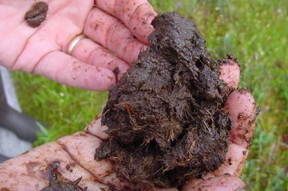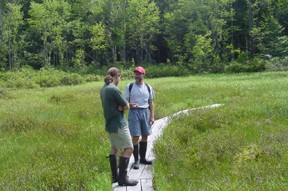Cornell biologists aim to grow 'bugs' responsible for greenhouse gas, methane, in NSF-funded microbial observatory
By Roger Segelken
They've been at it for millions of years, but practically nothing is known about wetlands bacteria that turn organic matter into the greenhouse gas, methane.
Now a team of Cornell University scientists, aided by a $837,000 Microbial Observatory grant from the National Science Foundation (NSF), is going after methane-generating bacteria (called methanogens) and other microbes that help digest dying plants in anaerobic (without oxygen) conditions of bogs and other wetlands – aiming to bring 'em back alive.
"Alive is the hard part. We can collect and distinguish the various methanogens by DNA analysis, but no one has ever cultured and grown methanogens from acidic wetlands in a laboratory," says Stephen Zinder, Cornell professor of microbiology. "We need to know more about the conditions where the methanogens work, especially in the highly acidic bogs."
If the Cornell researchers succeed in duplicating the carbon-rich, anaerobic, acidic conditions where the methanogens thrive, Zinder says, the hard-working bugs could have a future in bioengineering – perhaps in bioremediation of contaminated sites or in the controlled production of methane.
Among the gases accumulating in the atmosphere, and purportedly contributing to the greenhouse effect and global warming, methane is 21 times as potent as carbon dioxide, according to the U.S. Environmental Protection Agency. Increasing amounts of methane come from anthropogenic (or human-based) activity, particularly from burning coal, cultivating rice, raising livestock and producing natural gas, as well as from the decaying contents of garbage landfills. Harder to quantify and predict is "natural" methane production from wetlands, the possible result of plant growth and decomposition responding to temperature, carbon dioxide levels and other fluctuations during global climate change. That's why one of the observatory sites chosen for the Cornell study is McLean Bog, a few miles northeast of Cornell's Ithaca campus, where sphagnum moss and other plant materials have been accumulating for some 13,000 years, ever since a massive chunk of glacier from the last great ice Age melted and left a kettle-like hole in the surrounding gravel. Carnivorous pitcher plants and other exotic growth cover the surface of the bog, but researchers in the Microbial Observatory project are interested in deeper, more mysterious life-forms. Their goal is to extract methanogens, and other bacteria that help them flourish, by breaking down plants and simulating bog conditions, including acidity of pH 3.6, in the laboratory. (A measurement of pH 3.6 would make a bog roughly equivalent to the acidity of green olives.)
Other observatory sites are not as acidic, but are just as intriguing, according to the other co-principal investigator in the studies, Cornell associate professor of natural resources Joseph Yavitt, who has studied methane-producing wetlands in the northern United States since 1992. "We will look at a different type of peat land called a forested mire – as in quagmire – in Tully, N.Y.," Yavitt says. "The Tully site is a remnant of the forested mires that probably existed throughout the Lake Ontario plain before settlers drained the land. If you look at the mucklands used to raise onions and other crops south of Lake Ontario, you are seeing the same kind of soil that began forming 13,000 years ago but without the trees of a forested mire." Typical mires have lower rates of methane production and only one methanogen in common with bogs like the McLean Bog, Yavitt has learned.
Also targeted as a part of the Microbial Observatory project is Michigan Hollow in Danby, N.Y., where Cornell researchers report a very high rate of decomposition of plant materials, and the result is an oily, black substance that is a precursor to coal. Student participants in the study will visit comparable peat sites in Canada and Europe and will offer their findings on public web sites about methanogens.
As for the increasing amount of methane entering the atmosphere, Zinder says: "If we can understand how microbial populations in peat lands function, we may be able to predict how methane production will respond to changing environmental conditions, and that will greatly improve our ability to forecast trends in atmospheric methane concentration."
Related World Wide Web sites:
- Cornell Dept. of Natural Resources: http://www.dnr.cornell.edu/
Media Contact
Get Cornell news delivered right to your inbox.
Subscribe
